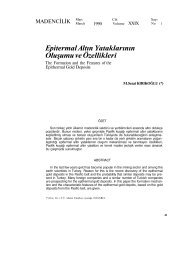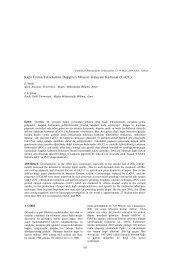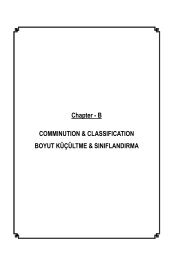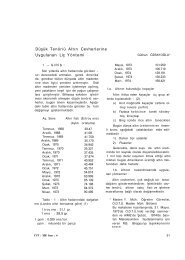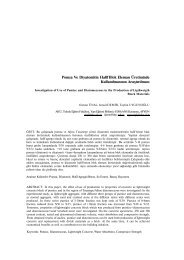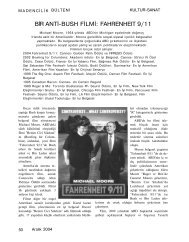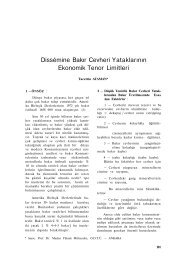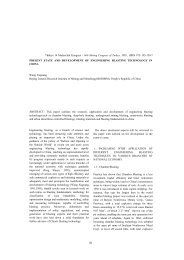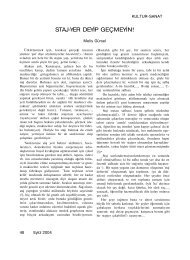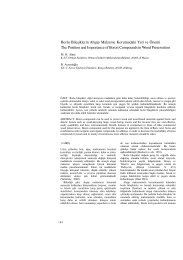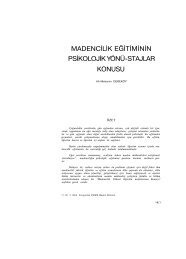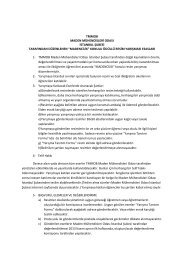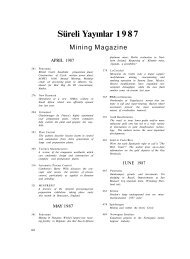A OPEN PIT MINING AÇIK OCAK MADENCİLİĞİ
A OPEN PIT MINING AÇIK OCAK MADENCİLİĞİ
A OPEN PIT MINING AÇIK OCAK MADENCİLİĞİ
You also want an ePaper? Increase the reach of your titles
YUMPU automatically turns print PDFs into web optimized ePapers that Google loves.
4.1.13 Loess exploitation<br />
Figure 10. Allocation of sandstone and<br />
conglomerate quarries on geostructural units<br />
(1=Apuseni Mountains; 2=Eastern<br />
Carpathians; 3= North-Dobrogean<br />
Structogen; 4=Central Dobrogean Massif; 5<br />
= South-Dobrogean Platform).<br />
5.1.10 Marl exploitation<br />
The marl was extracted in 24 quarries from<br />
12 counties: Bihor (Alesd, Hotar, Fisca<br />
quarries), Botosani (Stefanesti), Brasov<br />
(Tarlungeni), Cluj (Sandulesti), Dambovita<br />
(Crevedia, Malu Rosu, Scaiosi, Muchea<br />
Alba), Maramures (Poiana Botizei, Botiza),<br />
Harghita (Bradesti, Lueta), Hunedoara<br />
(Hotar, Prisloape), Mehedinti (Carabasita,<br />
Gura Vaii, Varciorova), Neamt (Cisirig,<br />
Ciritei, Tepeseni), Prahova (Gura Beliei),<br />
Sibiu (Dealul Daii).<br />
5.1.11 Conglomerate exploitation<br />
17 conglomerate quarries were registred in<br />
Arad (Siria, Padurea Neagra, Mezeriu<br />
quarries), Bistrita Nasaud (Ciceu), Brasov<br />
(Vlades, Dealul Alb, Talineu), Caras Severin<br />
(Iablanita), Constanta (Sibioara), Prahova<br />
(Predeal), Salaj (Fundu Luncii, Zalau),<br />
Suceava (Magura I-II, Muncelu) and Tulcea<br />
(Baia, Blasova) counties.<br />
5.1.12 Chalk exploitation<br />
From the Roman period to present, the chalk<br />
was extracted only in Constanta county. Was<br />
identified 12 quarries (Murfatlar I-V, Cainac<br />
I-II, Basarabi, Valea Seaca, Cuciuc, Cuciuc<br />
Murvat, Calea Omurcea) but dubtlessly their<br />
number is bigger.<br />
In the east and south areas of the Romania<br />
the dust sediments from Pleistocene epoch<br />
(Quaternary period) had generated loess and<br />
loessoid deposits. In some counties, the loess<br />
was extracted: Bacau (Calugara, Magura<br />
quarries), Constanta (Cobadin, Mamaia Sat,<br />
Siminoc, Medgidia I-II), Ialomita (Fierbinti,<br />
Slobozia, Tandarei, Urziceni I-II), Ilfov<br />
(Buftea), Teleorman (Alexandria) and<br />
Bucharest.<br />
5.1.14 Travertine exploitation<br />
In Quaternary (at the limit of the upper<br />
Pleistocene-holocene epochs) period, from<br />
underground warm solutions were generated,<br />
at the surface of the ground, in some areas,<br />
travertine deposits. The travertine<br />
occurrences are located in Hunedoara county<br />
(Banpotoc, Carpinis, Geoagiu, Rapolt<br />
deposits) and Harghita county (Boresec<br />
deposit) (Marinescu et al., 2005 b).<br />
They had been extracted in 21 quarries<br />
from Mehedinti (Breznita Roman quarry),<br />
Harghita (Borsec I-III), Hunedoara<br />
(Banpotoc I-III, Banpotoc – Carpinis I-IX,<br />
Geoagiu I-II, Rapoltu Mic, Carpinis I-II)<br />
countries.<br />
5.1.15 Other sedimentary rocks exploitation<br />
The most important diatomite deposits from<br />
Romania are in Arad, Buzau, Constanta and<br />
Covasna counties (Brana et al., 1986).<br />
Identified diatomite quarries there are in<br />
Arad, Buzau, Constanta and Covasna<br />
counties.<br />
From Roman period to present, calcareous<br />
tuff quarries are known in Bihor, Caras<br />
Severin and Hunedoara counties. The slate<br />
was extracted in Arad, Mehedinti and Tulcea<br />
counties. The marl-limestone was exploited<br />
in Mehedinti and the clay schist in Caras<br />
Severin counties (Parvu et al., 1977).<br />
204



